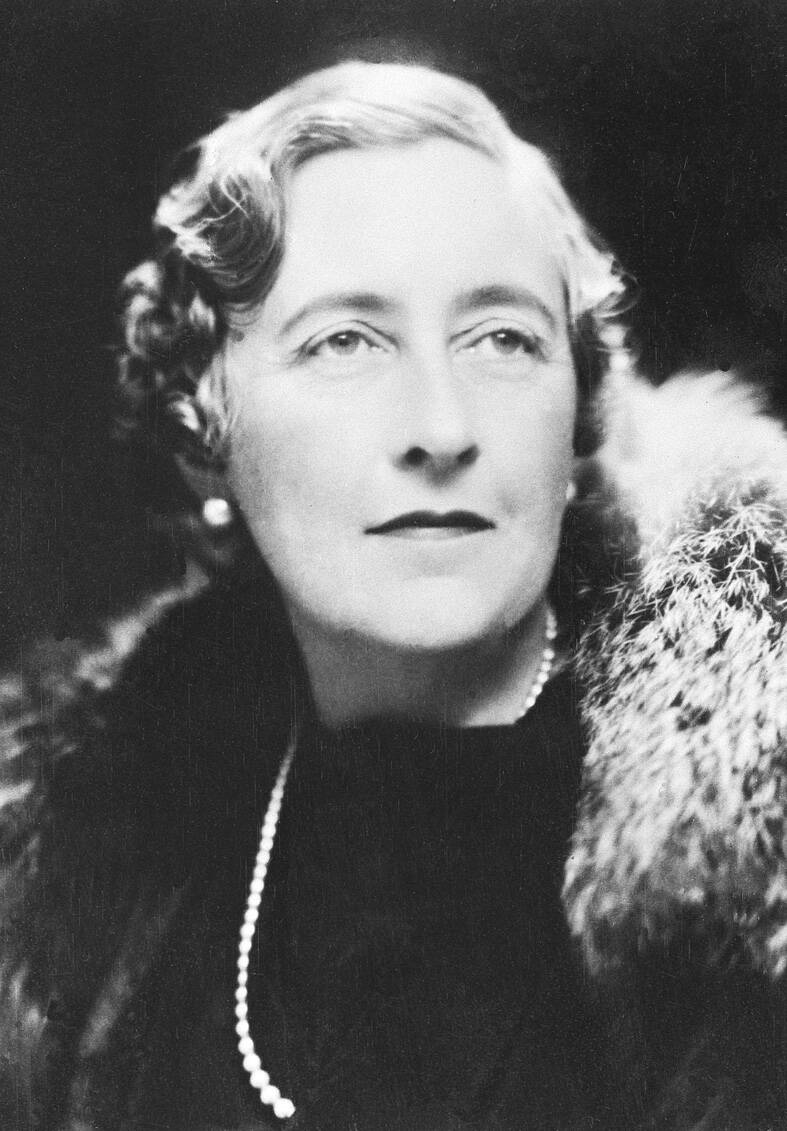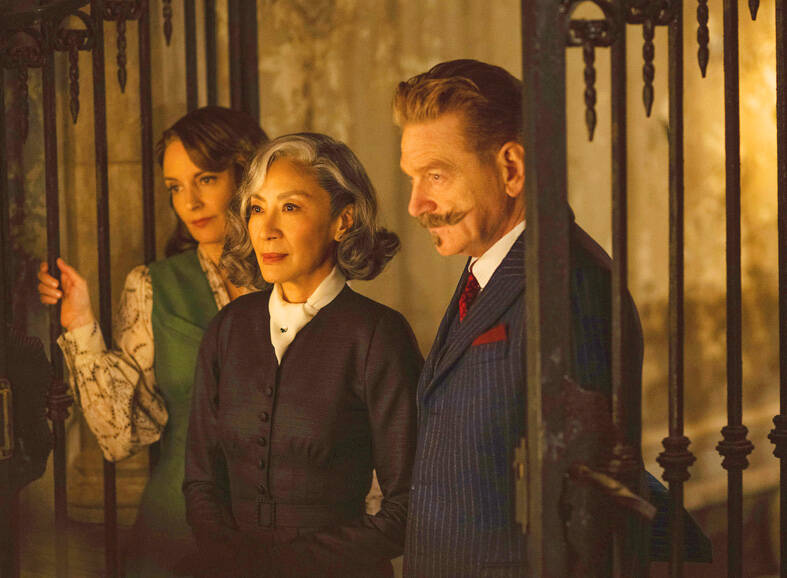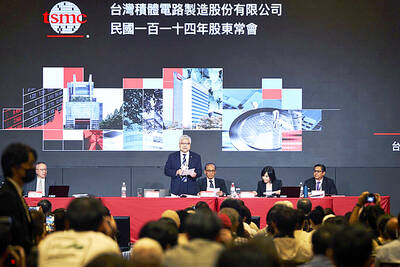Agatha Christie’s 1930s typewriter and the manuscript of her final Hercule Poirot novel, which was kept for decades in a bank vault, yesterday went on display in a new exhibition delving into the “dark stuff” at the heart of crime fiction.
The cover of the faded and fragile manuscript has the book’s title Curtain written in capital letters in Christie’s own hand along with her name and address — Greenway House in Devon, southwest England — in spidery longhand.
“She wrote it as a nest egg for her daughter Rosalind, ‘something to cheer you up when you come back from the funeral,’” said crime novelist Nicola Upson, curator of the “Murder by the Book” exhibition at Cambridge University Library in central England.

Photo: AP
The last Poirot mystery, in which Christie’s fabled Belgian detective dies, was written in the early 1940s during World War II in case she did not survive.
At the time “nothing was guaranteed,” Upson said.
Christie actually went on to write many more Poirot novels before she died in 1976, but with the final installment already written, fears Poirot’s demise might be leaked dictated that the manuscript be kept under lock and key.

Photo: 20th Century Studios via AP
“It’s Poirot’s last case and she wanted that to come out after her own death and for the royalties from it to benefit her daughter,” Upson said.
Poirot’s fate, when it was finally revealed in 1975, was seen as so culturally significant it was marked by a front page obituary in the New York Times.
“It ended up being published four months before her own death in January 1976, so when you read Poirot’s final words in that book they do read a bit like Christie’s farewell to her readers, there’s a poignancy to it,” Upson said.
Christie, who also wrote the Miss Marple series, is the best-selling fiction author of all time. She sold an astonishing 300 million books during her lifetime.
Nearly half a century after her death, objects such as her clunky 1950s Dictaphone and portable 1937 Remington typewriter — on which she would have written one of her most famous works And Then There Were None — still have the power to fascinate.
“There is something so evocative about the first to witness all those thoughts and stories,” said Upson, author of the Josephine Tey series of mysteries.
The exhibition draws on the library’s 1 million-strong fiction collection of first editions — still in their original dust jackets — by highlighting nearly 100 of the most famous, influential and best-selling crime novels in UK history.
Upson said she wanted to look not just at the “so-called cosy mysteries,” but also “the dark stuff, the kind of nuts and bolts of crime fiction which is after all violence and death.”
Forgotten classics also feature such as A Pin to See the Peepshow by F. Tennyson Jesse, which was inspired by the conviction and 1923 execution of Edith Thompson and Frederick Bywaters.
In Jesse’s 1934 novel, protagonist Julia Almond meets a similar fate in an ordeal described as amongst the “most horrific in all crime fiction.”
The book was influential in the UK’s abolition of the death penalty for murder three decades later in 1969.
As well as early fictional characters such as Miss Marple, Poirot and Arthur Conan Doyle’s Sherlock Holmes, the exhibition also features more recent creations such as Lynda La Plante’s Jane Tennison and Colin Dexter’s Inspector Morse.
Despite changes in style over the decades Upson said the essentials of good crime writing remain the same: “Strong characters ... a really realistic, atmospheric world ... and a strong story with a beginning middle and end, not necessarily in that order.”

With an approval rating of just two percent, Peruvian President Dina Boluarte might be the world’s most unpopular leader, according to pollsters. Protests greeted her rise to power 29 months ago, and have marked her entire term — joined by assorted scandals, investigations, controversies and a surge in gang violence. The 63-year-old is the target of a dozen probes, including for her alleged failure to declare gifts of luxury jewels and watches, a scandal inevitably dubbed “Rolexgate.” She is also under the microscope for a two-week undeclared absence for nose surgery — which she insists was medical, not cosmetic — and is

CAUTIOUS RECOVERY: While the manufacturing sector returned to growth amid the US-China trade truce, firms remain wary as uncertainty clouds the outlook, the CIER said The local manufacturing sector returned to expansion last month, as the official purchasing managers’ index (PMI) rose 2.1 points to 51.0, driven by a temporary easing in US-China trade tensions, the Chung-Hua Institution for Economic Research (CIER, 中華經濟研究院) said yesterday. The PMI gauges the health of the manufacturing industry, with readings above 50 indicating expansion and those below 50 signaling contraction. “Firms are not as pessimistic as they were in April, but they remain far from optimistic,” CIER president Lien Hsien-ming (連賢明) said at a news conference. The full impact of US tariff decisions is unlikely to become clear until later this month

GROWING CONCERN: Some senior Trump administration officials opposed the UAE expansion over fears that another TSMC project could jeopardize its US investment Taiwan Semiconductor Manufacturing Co (TSMC, 台積電) is evaluating building an advanced production facility in the United Arab Emirates (UAE) and has discussed the possibility with officials in US President Donald Trump’s administration, people familiar with the matter said, in a potentially major bet on the Middle East that would only come to fruition with Washington’s approval. The company has had multiple meetings in the past few months with US Special Envoy to the Middle East Steve Witkoff and officials from MGX, an influential investment vehicle overseen by the UAE president’s brother, the people said. The conversations are a continuation of talks that

CHIP DUTIES: TSMC said it voiced its concerns to Washington about tariffs, telling the US commerce department that it wants ‘fair treatment’ to protect its competitiveness Taiwan Semiconductor Manufacturing Co (TSMC, 台積電) yesterday reiterated robust business prospects for this year as strong artificial intelligence (AI) chip demand from Nvidia Corp and other customers would absorb the impacts of US tariffs. “The impact of tariffs would be indirect, as the custom tax is the importers’ responsibility, not the exporters,” TSMC chairman and chief executive officer C.C. Wei (魏哲家) said at the chipmaker’s annual shareholders’ meeting in Hsinchu City. TSMC’s business could be affected if people become reluctant to buy electronics due to inflated prices, Wei said. In addition, the chipmaker has voiced its concern to the US Department of Commerce